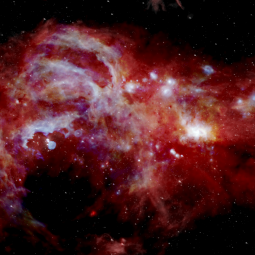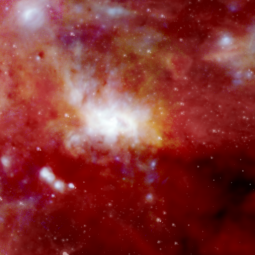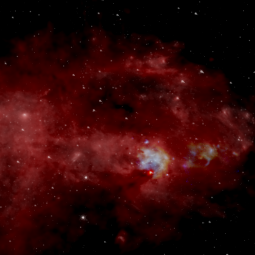By Matthew Hankins
Paper:
SOFIA/FORCAST Galactic Center Legacy Survey: Overview
Hankins et al., 2020, ApJ.
SOFIA’s first completed legacy program provides researchers with a vastly improved view of warm dust in the center of the Galaxy, revealing signatures of star formation in exquisite detail.
The inner ~200 pc of the Milky Way contains some of the most extreme conditions for star formation in our Galaxy — high molecular gas densities, high gas and dust temperatures, significant turbulence, and a strong gravitational potential well. It’s thought that the environment in the Galactic center is somewhat similar to what is found in actively star forming galaxies, yet its relative proximity enables detailed study of physical processes at a level that is inaccessible in more distant galaxies. However, the global star formation rate of the Galactic center is deficient by more than an order of magnitude compared to theoretical expectations based on its molecular gas reservoir. This inefficiency in transforming dense gas into stars is a significant quandary in our understanding of the region and has potentially broad implications for observational star formation tracers that are used to study other galaxies.
Several common star formation diagnostics at optical and UV wavelengths cannot be used to study the Galactic center because of heavy extinction caused by gas and dust along our line of sight. Instead, studies of star formation have largely relied on infrared observations from missions like Spitzer and Herschel which were able to pierce through the line of sight dust. Warm dust emission at ~24 μm is a particularly useful probe of recent star formation activity; however, the brightest regions within the inner ~200 pc are badly saturated in the Spitzer/MIPS 24 μm data. This saturation issue posed a significant hurdle for studying star formation in the Galactic center as well as numerous other topics in which mid-infrared observations are crucial.
Recent observations from SOFIA were used to create high-quality mosaics of the most active star forming portions of the inner ~200 pc of our galaxy at 25 and 37 μm. These observations were taken as part of SOFIA’s first completed legacy program which used the FORCAST instrument to image warm dust associated with star formation activity in the region. The SOFIA mosaics have an angular resolution of 2.3" and 3.4" for the 25 and 37 μm observations, respectively, and cover more than 99% of the hard saturated area in the corresponding Spitzer/MIPS mosaic. An overview paper meant to accompany the first survey data release has recently been accepted to ApJ and further details of the observations can be found therein.
One of the more interesting pieces in the overview paper considers a collection of isolated mid-infrared sources located between Sgr A and Sgr C. It is widely thought that the majority of star formation activity in the Galactic center is present at positive galactic longitudes; however, these sources at negative longitudes are curious because several are classified as young stellar object candidates in a prior survey. With the angular resolution provided by SOFIA/FORCAST (2.3" or 0.09 pc assuming a distance of 8 kpc), it is possible to study the morphology of these sources in detail which show a range from compact bubbles to arc-like structures which could be indicative of a bow shock. Even more curious is an nearby extended 37 μm source, G359.645-0.081, which is unusually red and has prior Spitzer/IRS spectroscopic observations which indicate the presence of a hard ionizing source near this position. Further study is needed to better understand this complex, though we note that the source lacks a significant x-ray component, indicating it is unlikely a supernova remnant.
In addition to the collection of isolated sources discussed above, the overview paper features a number of other short segments on well-known regions within the survey area such as Sgr A, Sgr B, and Sgr C, as well as the Arched filaments HII region and the Sickle HII region. Finally, the survey team are currently working to produce high level data products including a point source catalog with color selected YSO candidates, a dust temperature map derived using the 25 and 37 μm observations, and an additional map that combines the SOFIA/FORCAST 25 μm and Spitzer/MIPS 24 µm data sets that will greatly expand the coverage area and dynamic range of both datasets. These data products will be made available to the broader SOFIA community as part of a later data release and will likely appear along with subsequent follow-up papers that are discussed in the survey overview paper.
SOFIA, the Stratospheric Observatory for Infrared Astronomy, is a Boeing 747SP jetliner modified to carry a 106-inch diameter telescope. It is a joint project of NASA and the German Aerospace Center, DLR. NASA’s Ames Research Center in California’s Silicon Valley manages the SOFIA program, science and mission operations in cooperation with the Universities Space Research Association headquartered in Columbia, Maryland, and the German SOFIA Institute (DSI) at the University of Stuttgart. The aircraft is maintained and operated from NASA’s Armstrong Flight Research Center Building 703, in Palmdale, California.



